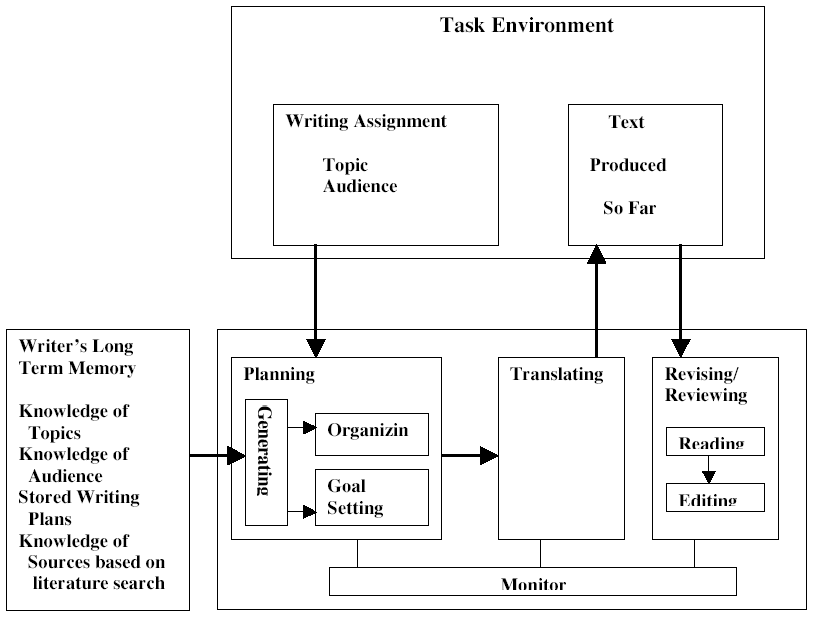
The Cognitive Process Model of the Composing Process (Flower and Hayes, 1981)
The basic insight of the Flower and Hayes model has been confirmed by countless later studies. They set out to map the actual mental behaviors of experienced writers at work, and they represented them as a "flow chart" of boxes indicating processes (e.g., "Revising/Reviewing") and sub-processes (e.g., "Reading"), and arrows indicating information flow between them. Building upon the work of previous composition researchers, they helped us identify separate sub-skills of the composing process which writers might need to practice using in concert together, and they helped redirect composition teaching and tutoring toward a more holistic view of writing as an event in writers' lives.
Before Flower and Hayes produced their model, other researchers had disproved the popular late-twentieth-century model of the composing process that taught it occurred in three, non-reversible linear stages: pre-writing, writing, and revision. By observing and listening to inexperienced and experienced writers at work, Sondra Perl, Nancy Sommers, and others discovered big differences in how those writers worked. Experienced writers combined elements of all three "stages" in complex but identifiable ways to think their way toward a finished written document. Thus, for them, writing is not linear, except perhaps in the forward movement of "Translation," in which thoughts are cast into sentences, and in moments of "Reading" in aid of "Revision," when parts of the writing are replayed linearly in the mind. Instead, most of the composing process is complex, multi-layered and recursive, so that many of those processes can be operating at once, and information can flow back and forth among boxes in several directions at once.
Inexperienced writers who have been taught the traditional "pre-writing," "writing," "editing" sequence may try to ignore or shut down parts of the process which do not seem to fit. This can tempt them to lazy behaviors like refusing to re-examine their purposes in writing or the audience's needs once they have a finished draft, or limiting revision to word changes and re-punctuation rather than reorganizing the whole text and writing new major sections. They also may become trapped in tiny "loops" in the process. This is especially destructive when they oscillate mainly between "Text Produced So Far" and "Revising/Reviewing" as they repetitively correct sentence-level "mistakes" before moving forward (Perl, 1979, and Sommer, 1980). That prevents their "Monitor" from consulting their larger purposes in writing and the logical shape of the paragraph or whole text. This prevents writers from discovering genuinely new ideas while writing, because their attention is absorbed by the pursuit of real or imagined mechanical errors. (This is not to say that error correction is not important, but when it, and fear of the Audience, dominate the process, they stifle creative logical thinking.)
Since its introduction, this flow-chart model of writing processes has been subjected to many important critiques, notably Brand ("The Why of Cognition"), Bizzell (“Cognition, Convention, and Certainty: What We Need to Know about Writing"), and Faigley ("Competing Theories of Process"). Much of the "growth" in this model as a result of these criticisms happened because emotional and social influences on writers came to be recognized as essential elements in how we write. These usually are located in the left-hand box and the "Writing Assignment" sub-box, where emotions, ethical judgments, social context and interaction, and a host of other elements from the writer's internal and external experiential universe shape the relatively bland functions which fill the cognitive-process elements like "Goal Setting" or "Editing." Also, the arrows indicating information flow are widely understood to be "double-headed," so that (for instance) "Editing" can lead to the need for more "Reading" and attempts to "Generate Goals" might meet with a block that sends the writer's mind back to those "Stored Writing Plans" or "Knowledge of Audience." The really mysterious part of this, its "soul," is the "Monitor" which seems to oversee its operations in some important way ("how am I doing?" "YES!--that word is going to drive readers crazy!" "do I need a doughnut, coffee, sleep?" "should this sentence be deleted?").
This past success of this model's terminology among scholars in the 1980s-1990s does not stop "social constructivist" scholars from trying to declare the "process model" of composition "dead" by announcing that we are now in the "Post-Process Era" (cf. Post Structuralism, Post Feminism, etc.). For an interesting review of a 1999 essay collection based on that assumption, see Kevin J. Porter's thoughtful response in the online journal, JAC (2000) to Post-Process Theory: Beyond the Writing-Process Paradigm, Thomas Kent, ed. (Carbondale: Southern Illinois UP, 1999).
Works Referred to on this Page:
Bizzell, Patricia. "Cognition, Convention, and Certainty: What We Need to Know About Writing." Pre/Text: A Journal of Rhetorical Theory. 3:3 (Fall 1982): 213-43.
Brand, Alice G. "The Why of Cognition: Emotion and the Composing Process." College Composition and Communication. 38:4 (December 1987): 436-43.
Faigley, Lester. "Competing Theories of Process: A Critique and a Proposal." College English 48:6 (October 1986): 527-42.
Flower, Linda, and John R. Hayes. "A Cognitive Process Theory of Writing." College Composition and Communication. 32:4 (December 1981): 365-87.
Perl, Sondra. "The Composing Processes of Unskilled College Writers." Research in Teaching English. 13:4 (December 1979): 317-36.
Porter, Kevin J. [Review of Post-Process Theory: Beyond the Writing Process Paradigm]. JAC. 20:3 (2000). Online. Viewed 6/3/04. Available at http://jac.gsu.edu/jac/20.3/Reviews/3.htm
Post-Process Theory: Beyond the Writing-Process Paradigm. Thomas Kent, Ed. Carbondale, Ill.: Southern Illinois UP, 1999.
Sommers, Nancy. "Revision Strategies of Student Writers and Experienced Adult Writers." College Composition and Communication. 31:4 (December 1980): 378-88.